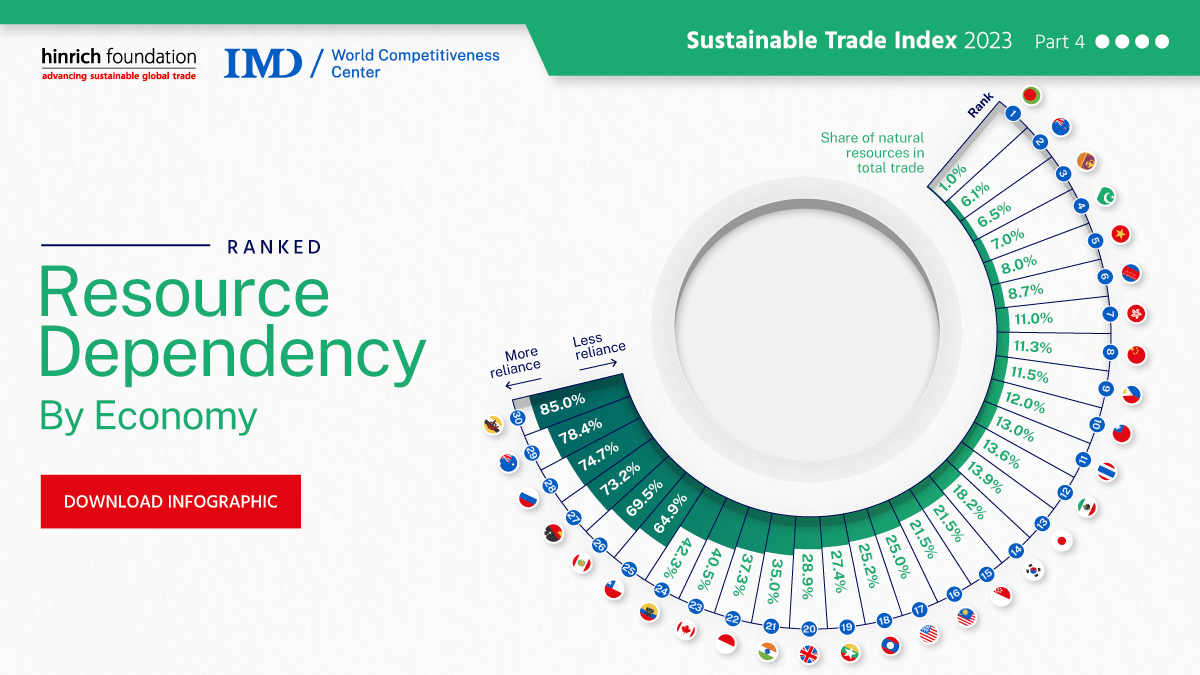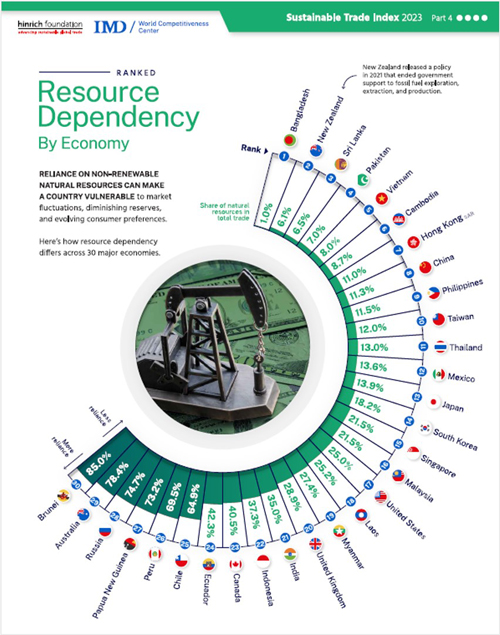Published 16 January 2024
Achieving sustainability in trade requires prudent stewardship of environmental capital. Visual Capitalist illustrates the degree of dependency on natural resources among 30 key trading economies.
(Text by Chuin Wei Yap)
Overreliance on non-renewable natural resources can make an economy vulnerable to global market changes and fickle consumer preferences. In an age of swiftly evolving and Great Power geopolitical rivalry and climate change, resource dependency is becoming more than ever an indicator of exposure and potential weakness in an economy’s ability to trade in a sustainable way.
Vancouver-based data artists Visual Capitalist illustrates how a range of major trading economies around the world fare in this measure, based on findings in the environmental pillar of the Hinrich-IMD Sustainable Trade Index, which uses 71 indicators across economic, societal, and environmental sectors to assess how ready an economy is to conduct sustainable international trade. The index was developed by the Hinrich Foundation in collaboration with Switzerland’s IMD World Competitiveness Center.
When raw materials account for 60% or more of a country’s merchandise export revenue, the economy is deemed to be “commodity dependent,” according to the United Nations Conference on Trade and Development. “While such dependence is a global concern, it affects developing countries the most,” UNCTAD said in an October report. “Only 13% of advanced economies make the list, including Australia and Norway, compared with a staggering 85% of the world’s least developed countries.”
New Zealand, perhaps not surprisingly given its well-balanced overall trade policy, ranks second in terms of the share of natural resources in an economy’s total trade. But the top five also includes smaller, less developed countries including Bangladesh, Sri Lanka, and Pakistan. A variety of structural reasons may explain this: Bangladesh doesn’t have a lot of mineral resources and depends heavily on its garment industry for trade. Sri Lanka hasn’t invested much in its resource sector. Pakistan has an abundance of resources but remains relatively politically volatile for the scale of investment needed to develop such trade.
At the bottom of the ranking is Brunei, whose economy is almost entirely about oil. Australia is second-largest, as its major exports are concentrated in mining minerals from iron ore to coal and bauxite. Russia, third-last in the rankings, is a major resource exporter now paralyzed by its invasion of Ukraine. Papua New Guinea, fourth-last, depends heavily on its nickel exports to China.
Policy changes are driving some degree of changes. “With extreme weather conditions now making the seriousness of climate issues irrefutable, economies and companies must rethink their strategies,” our STI white paper says.
Resource dependency is one key area in which we expect the STI to be particularly useful, by allowing economies to use a comparative analysis of their performance to gauge their trade sustainability.
© The Hinrich Foundation. See our website Terms and conditions for our copyright and reprint policy. All statements of fact and the views, conclusions and recommendations expressed in this publication are the sole responsibility of the author(s).







